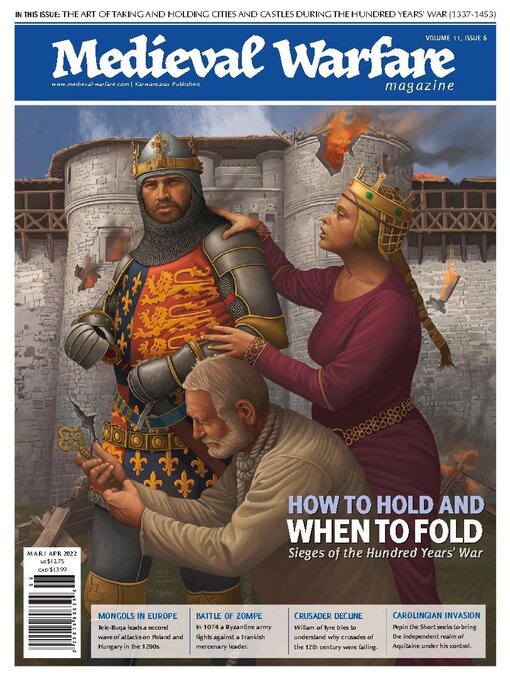Medieval Warfare picks up where its sister magazine, Ancient Warfare, leaves off. Starting around 500 AD, Medieval Warfare examines the world during the Middle Ages up through the early years of the Renaissance (the magazine generally leaves off in the 16th century). While popular topics such as the Crusades and the Vikings are given regular coverage, Medieval Warfare also tackles more complex and obscure topics, ranging from the Umayyad Caliphate versus the Byzantine Empire to horse trading in 14th-century England.
Medieval Warfare
Editorial
Marginalia
WRATH OF THE DOG • The 1240s invasions were not the end of the Mongol interactions with Europe. Attacks continued during the thirteenth century, and here we look at the most significant, the so-called Second Mongol Invasions of Hungary and Poland in the 1280s, led by Prince Nogai and the Khan of the Golden Horde, Tele-Buqa.
SOLDIERS ON THE HIGH SEAS • England, like many medieval kingdoms, did not have a professional navy. Although this might seem truly strange to modern audiences, there were several key reasons for this. The first is cost. The expense of building or buying a ship and keeping it seaworthy would have been a massive drain on the royal treasury. Second, one would need the related personnel. Providing its crew and captain along with other support would have been yet another heavy toll on the king’s pocketbook.
BATTLE AT THE BRIDGE OF ZOMPE • The decisive battle at the River of Sangarios, near the Zompe Bridge (AD 1074), should be examined alongside the internal uprisings and rebellions that marred the Byzantine Empire in the eleventh century. This battle was more decisive than Manzikert (1071). The victory of the Franks diminished the numbers of the imperial armies, leaving the easternmost provinces of the Empire open to constant raiding and unrestrained plundering by the Seljuks. The texts of the Byzantine historians Michael Attaleiates and Nikephoros Bryennios recount this story.
PEPIN VERSUS WAIFAR • In the year 760, the Frankish king Pepin the Short plunged early medieval France into a scorched-earth war of conquest that rivalled ancient Rome’s infamous campaign against Carthage.
A QUANTITATIVE RECONNAISSANCE • Sieges were the dominant form of warfare in the Middle Ages. They were far more common than battles, any specialist would confirm. But that apparent consensus is sustained only by the vagueness of the claim. Few writers have attempted to quantify the ratio between battles and sieges, but two prominent scholars who have done so reveal how wide a range of different beliefs could be covered by that broad statement: one says that “for every battle fought during the Middle Ages, perhaps a hundred or more sieges were undertaken,” while another far more conservatively proposes a ratio of “5:1-at least”. This goes for the Hundred Years’ War as well: there is general agreement that sieges were more frequent, with some stronger but still vague claims such as that sieges occurred “in vastly greater numbers”.
Froissart, Monstrelet and d’Escouchy
CRÉCY AND CALAIS FROM THE ARCHIVES • When studying the Hundred Years’ War, it can be tempting to focus on the many chronicle sources that present narratives of the unfolding of events from both the English and French perspectives. Yet, to do only this overlooks the invaluable information contained within many different kinds of administrative documents that clarify details of events, as well as providing organizational or logistical specifics about the various campaigns of the war, which the chronicles often ignore.
THE WAYS OF SIEGE WARFARE • During the Hundred Years’ War, a commander would know a number of ways to lay siege to an enemy position. Castles could be taken by escalade (using ladders to cross the defenders’ wall), by mining (tunnelling), or by bombardment resulting in...

 Issue 18 - 2025
Issue 18 - 2025
 Issue 17 - 2025
Issue 17 - 2025
 Issue 16 - 2025
Issue 16 - 2025
 Issue 15 - 2024
Issue 15 - 2024
 Issue 14 - 2024
Issue 14 - 2024
 Issue 13 - 2024
Issue 13 - 2024
 Issue 12 - 2024
Issue 12 - 2024
 Issue 11 - 2024
Issue 11 - 2024
 Issue 10 - 2024
Issue 10 - 2024
 Issue 9 - 2023
Issue 9 - 2023
 Issue 8 - 2023
Issue 8 - 2023
 Issue 7 - 2023
Issue 7 - 2023
 Issue 6 - 2023
Issue 6 - 2023
 Issue 5 - 2023
Issue 5 - 2023
 Issue 4 - 2022
Issue 4 - 2022
 Issue 3 - 2022
Issue 3 - 2022
 Issue 2 - 2022
Issue 2 - 2022
 Issue 1 - 2022
Issue 1 - 2022
 MW X11.1
MW X11.1
 MW X1.5
MW X1.5